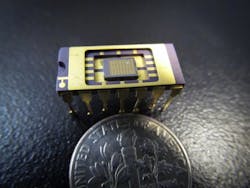Single-mode nanocavity LED sends data at just 0.25 fJ per data bit
Palo Alto, CA--A photonic-crystal nanocavity LED demonstrated by a group at Stanford University has a 10 GHz modulation speed and sends data at less than 1 fJ per data bit.1 The quantum-dot (QD)-based device operates at room temperature, is single-mode, and is easily integrated into on-chip photonic circuits for data communications.
"Traditionally, engineers have thought only lasers can communicate at high data rates and ultralow power," said Gary Shambat, a doctoral candidate in electrical engineering. "Our nanophotonic, single-mode LED can perform all the same tasks as lasers, but at much lower power."
Stanford's Jelena Vuckovic, an associate professor of electrical engineering, had earlier this year produced a nanoscale laser that was similarly efficient and fast, but it operated only at temperatures below 150 K, making it impractical for commercial use.
The new LED has indium arsenide QDs that are electrically pumped. The QDs are contained in a photonic crystal that serves as a resonator, forcing single-mode behavior.
Conventional low-power laser devices require about 500 fJ of energy per bit; the new LED device requires, on average, 0.25 fJ per bit. "Our device is some 2000 times more energy efficient than best devices in use today," said Vuckovic.
Source: http://news.stanford.edu/news/2011/november/data-transmission-breakthrough-111511.html
REFERENCE:
1. Gary Shambat et al., Nature Communications 2, article number 539; doi:10.1038/ncomms1543; published 15 November 2011.

John Wallace | Senior Technical Editor (1998-2022)
John Wallace was with Laser Focus World for nearly 25 years, retiring in late June 2022. He obtained a bachelor's degree in mechanical engineering and physics at Rutgers University and a master's in optical engineering at the University of Rochester. Before becoming an editor, John worked as an engineer at RCA, Exxon, Eastman Kodak, and GCA Corporation.
